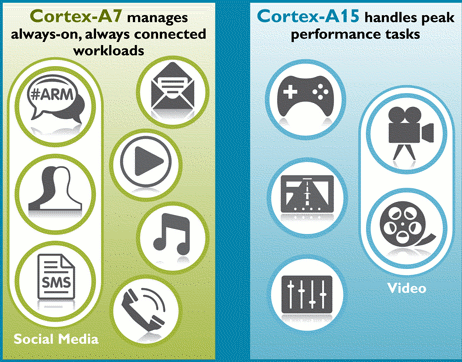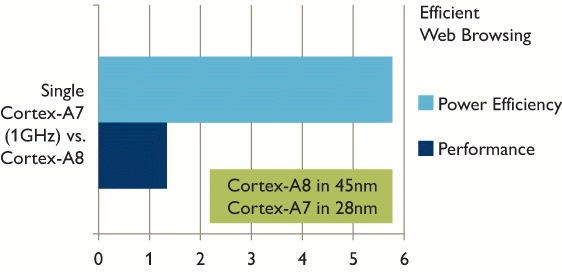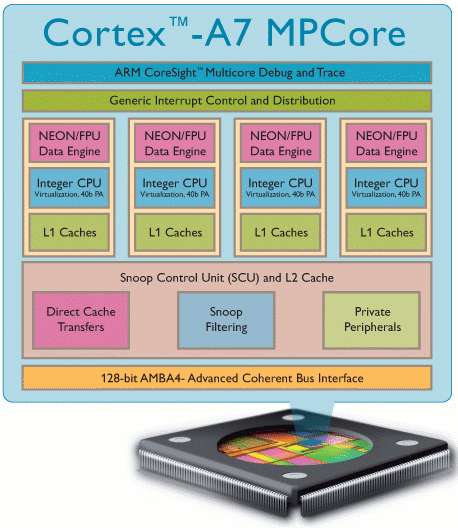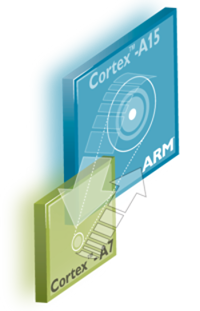ARM unveiled the Cortex A7, a new core with higher performance than the Cortex A8 (1.5x) and with 5 times less power consumption. It will be used in conjunction with Cortex-A15 Core and allows big.LITTLE processing where the Cortex A7 (companion core) takes care of the low performance, low power tasks (social network, email, SMS, phone calls) and the Cortex A15 kicks in for high performance tasks such as video processing and gaming.

Here’s an excerpt of the Cortex A7 / big.LITTLE processing press release:
ARM today announced the ARM® Cortex™-A7 MPCore™ processor – the most energy-efficient application class processor ARM has ever developed, and big.LITTLE processing – a flexible approach that redefines the traditional power and performance relationship. The Cortex-A7 processor builds on the low-power leadership established by the Cortex-A8 processor that is at the heart of many of today’s most popular smartphones. A single Cortex-A7 processor delivers 5x the energy-efficiency and is one fifth the size of the Cortex-A8 processor, while providing significantly greater performance. The Cortex-A7 processor will enable a rich user experience in sub-$100 entry level smartphones and help connect the next billion people in developing markets.
Big.LITTLE processing, enabled by Cortex-A7, achieves this by pairing the best of the high-performance Cortex-A15 MPCore and ultra-efficient Cortex-A7 processors. Big.LITTLE processing allows devices to seamlessly select the right processor for the right task, based on performance requirements. Importantly, this dynamic selection is transparent to the application software or middleware running on the processors
You can read the full press release on ARM website.
ARM says Cortex A7 processor is fully compatible with other Cortex-A series processor and incorporates all of the features of the high-performance Cortex-A15 processor including virtualization, large Physical Address Extensions (LPAE) NEON advanced SIMD, and AMBA 4 ACE coherency.
A single Kingfisher processor can deliver 5x energy-efficiency, 50% greater performance and is one fifth the size of the ARM Cortex-A8 processor, which powers many of today’s most popular smartphones.

The Cortex A7 can be used:
- As a Standalone CPU (with up to 4 cores) as it offers more performance than 2011 mainstream smartphone CPU as it provides up to 20% more performance while consuming 60% less power,
- As a Companion CPU to Cortex-A15 to enable big.LITTLE Processing:
- Software can run on an energy efficient Cortex-A7 processor
- And also on a high performance Cortex-A15 processor as needed
- Without recompilation !
- AMBA 4 ACE coherency interface enables sub-20us context migration between big and LITTLE CPU clusters

As a standalone processor, the Cortex-A7 will enable entry level smartphones at below 100 USD price point in the 2013-2014 timeframe that are equivalent to a 500 USD high-end smarphone in 2010.
I’m also convinced we should also see very low cost development board (maybe around 50 USD) using the technology with slightly better performance than the Beagleboard.
Several leading silicon manufacturers has already licensed the Cortex-A7 processor including:
- Freescale
- Texas Instruments
- Broadcom
- HiSilicon
- LG
- Samsung
- ST Ericsson
 ARM pushed the concept of companion core I first discovered with the NVidia Tegra 3 further with the Cortex A7. Here’s what the company says about the big.LITTLE processing technology:
ARM pushed the concept of companion core I first discovered with the NVidia Tegra 3 further with the Cortex A7. Here’s what the company says about the big.LITTLE processing technology:
big.LITTLE processing addresses one of today’s industry challenges: how to create a System on Chip (SoC) that provides both high performance as well as extreme power efficiency to extend battery life. big.LITTLE connects the performance of the ARM Cortex-A15 MPCore™ processor with the energy efficiency of the Cortex-A7 processor, and enables the same application software to be seamlessly switched between them. By selecting to optimum processor for each task big.LITTLE can extend battery life by up to 70%.
Since Cortex A7 and Cortex A15 use the same instruction set (ARMv7a), software developers won’t have to care on which core their software will run to take advantage of lower power consumption and longer battery life, although it will still possible to switch between cores with a software switcher.
ARM has done a big.LITTLE processing demo using Android Browser in Gingerbread using a big.LITTLE aware Power Management Driver. They will provide open source firmware for “state migration” between Cortex A7 and Cortex A15, but I could not find further info on this yet.
There is an obvious advantage in mobile devices like smartphone and tablets, but ARM expects this technology to also be used in datacenters where they have pressure to keep electricity bills low. The Cortex A7 would be active during periods of low traffic (e.g. night time, week-end) and during burst of traffic the Cortex A15 would take care of the extra load.
Cortex A15 will have a bit over than twice the performance of the Cortex A7, but the Cortex A7 will consume 3.5 times less than the Cortex A15.
You can read big.LITTLE Processing with the Cortex-A15 and Cortex-A7 Processors white paper for further details on the technology.

Jean-Luc started CNX Software in 2010 as a part-time endeavor, before quitting his job as a software engineering manager, and starting to write daily news, and reviews full time later in 2011.
Support CNX Software! Donate via cryptocurrencies, become a Patron on Patreon, or purchase goods on Amazon or Aliexpress




